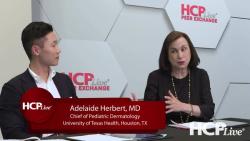Addressing Patient Needs in Seborrheic Dermatitis with Novel Therapies - Episode 13
Beyond Skin Deep: Validating and Transforming SD Patient Care
Dermatologists end their discussion on seborrheic dermatitis (SD), highlighting key takeaways for patients and clinicians on managing this condition.
Transcript
Linda Stein Gold, MD: As we kind of wrap things back around, we’ve all been in practice for a good amount of time. I think we all have kind of a unique perspective on treating patients with seborrheic dermatitis. I’m just wondering, based on the information that you’ve seen, based on your own clinical practice and any clinical trials, if you could think about some kind of a pearl that you would give to our viewers to take home, maybe to make us all a little bit better in our prescribing or our understanding the needs of a seborrheic dermatitis patient. Adelaide, I’m going to start with you, talking about children, is [there] some special way to communicate or [do] you know some special kernel of truth that you’ve learned in treating a seborrheic dermatitis pediatric patient?
Adelaide Hebert, MD: Well, I think one of the first things I do is I reassure them that it is a treatable problem and that we have tools that will be helpful. And we also have on the horizon some medicines which I’m always proud to say that I’ve had a small role in bringing forward hopefully to the market, and they’ll be coming soon, and I’ll update them as we go along. I think addressing it front and center as a medical problem for which we have treatments and hopefully, soon, better treatments is reassuring. The other thing I say is we take this seriously. I’ve had too many patients come in and say [that] the doctor barely looked then they left the room. “I got a prescription, but then what do I do?” They don’t feel that they’re really feeling validated, so [as] I do often with many disease states I say [that] we take this seriously, and they tell me how grateful they are to hear somebody say that.
Linda Stein Gold, MD: Adelaide, I think I’m taking that home. I want to tell my patients from now, “I take this very, very seriously,” because I think I want to be heard as a patient. I want you to hear what I’m saying and understand that this is important to me even if it doesn’t look like it’s so terrible; I want I want my physician to hear me and understand what I’m saying. James, thoughts on anything that you can give us to take home?
James Song, MD: Just to validate the patient’s concerns and the impact that it has on her life. [Telling them,] “Hey, it’s OK for you to feel this way about your condition. It’s not too trivial, and [I] take it very seriously.” I also thinking establishing that this is a condition that we’re going to be able to treat. It’s not a cure, but we’re going to treat this. We have really good treatments now on the horizon that could really help you get to the place you want to be.
Shawn Kwatra, MD: I think it’s important not to make judgments based on how their seborrheic dermatitis may appear. It’s important to ask patients about their symptoms. In particular, I really focus on asking about their itch. I’ve been surprised so many times. And I think seborrheic dermatitis is just one of those diseases where itch can be a significant burden. You should ask them about it. And now we have the emergence of [a] novel therapeutic that can reduce itch so quickly.
Linda Stein Gold, MD: It’s so interesting because I ask all of my atopic dermatitis patients, talk to me about your itch. That’s so easy because it’s so quick, and I can write it down. I don’t have to do a whole EASI [Eczema Area and Severity Index] score. I can ask them about their itch, do an overall IGA, or investigator’s global assessment. I’ve learned that itch is very important for my psoriasis patients. So now I try to ask my patients [about it]; not [that] everybody itches, but a significant number of psoriasis patients do itch. But I haven’t always asked my seborrheic dermatitis patients about their itching. I think that we could all kind of take that back, and maybe that will make us even better in terms of understanding their burden and being able to monitor it a little bit closer.
Neal Bhatia, MD: I think all of you said it best, but I would take it a step further and just make them unravel it and remind them of the itch, the dryness, the epidermal changes of scale, the redness, and then bring it back to why are we treating with all these different components of cleansing, moisturizing, and the active ingredient. But also make them think about the marathon and not the sprint, not just making [it] go away quickly, but making things stay away and the safety of giving them things that will do that.
Linda Stein Gold, MD: I think these are all such critical points. What I’m hearing from all of you, who are some of the best clinicians out there, is validating that they have a real medical condition and that they deserve appropriate therapy, that we hear them, we have new options that are available, we can help to simplify the treatment regimen, we can give them something that’s safe, effective, [and] well tolerated, and we can help them in this journey. My goal always is to make them not think about their skin. If they want to think about it in a good way, that’s great, if they’re happy with their skin, that’s great. I want you to live your life and your skin goes with you, but your skin should not be the center of how you live your life, trying to hide the flake, trying to hide the redness, trying to not scratch. I think this is really, really critical. I’ve learned a lot from my colleagues and from talking to each one of you. I think we have some really interesting information. I want to thank each of you for participating today, I’d like to thank the audience for joining us. I hope that you’ve all been able to take home some kernels of truth, and I’d like to thank you all for watching this HCPLive Peer Exchange, thank you all so much.
Transcript was AI-generated and edited for clarity.



